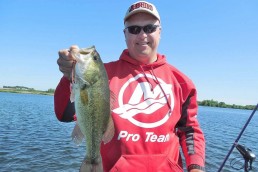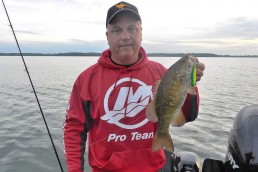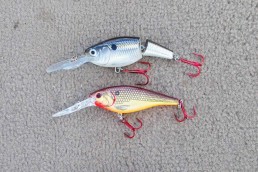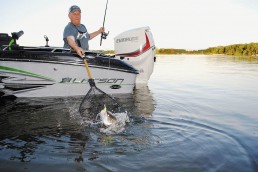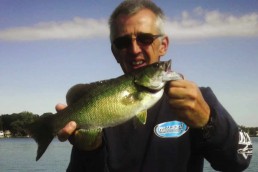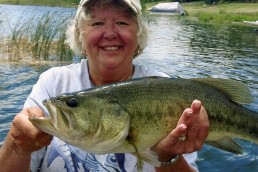Summertime Crankbaits Shine Around Weeds
SHARE THIS POST
I was watching a beautiful sunrise when my crankbait stopped swimming, my line went slack for a second and then pulled tight and started heading to the side. I love the strike of a walleye or bass on a crankbait.
My fishing buddy grabbed the net and scooped a nice walleye into the boat. We were casting crankbaits along a weed edge 8 to 10 feet on a Minnesota lake. It was a hot July day, and started with a few scattered clouds and some wind—the perfect conditions to work crankbaits along points and inside turns in a weedline. By the time the sun and heat drove us off the lake, about noon, we had boated three walleyes, one pike and 14 largemouth bass.
Most natural lakes have a fair amount of weed cover in them. These are home to prey during the summer, and attract the attention of many predators. You want to target the outside edges of the weedlines. The best weeds to target include cabbage, coontail, curly-leaf pondweed and milfoil. The edges of these weeds could be in water as shallow as 4 feet, and as deep as 20, depending on the weed types and the water clarity.
Not all weedlines are created equal. The best are wide, meaning they extend out quite a ways from the shoreline. Thick weed cover with sparser weeds on the outside edges is always a good spot. Points and pockets here are great to concentrate your efforts. A drop-off from the shoreline flat to the deeper water nearby is a big plus for finding fish along the weedline, but you’ll want a narrow area of a “cleaner” bottom between the edge of the weeds and the drop-off. This open area is a great feeding area for fish, and any time you can find some rock on a soft bottom near the weeds, you have found a fish magnet.
Early mornings and late evenings are often the best to fish weedlines in the summer. First, July and August mean recreational boat traffic on many lakes, and the fish will be the most active before the noise gets started or after it dies down. Second, you will often be fishing shallow to mid-depth areas depending on the lake. And lower light usually means more active fish in these areas. Cloudy or windy conditions, or both, can mean an active bite later in the morning or earlier in the afternoon and evening if boat traffic is relatively light. A few fish can be had any time of the day in these spots, but if you concentrate your efforts at the best times, you are more likely to experience fast action and are more likely to catch a variety of species.
Casting crankbaits is the best technique I know to fish weedlines in summer. This presentation allows you to fish fairly quickly, covering water in search of active fish. Crankbaits will trigger aggressive strikes from feeding fish and often trigger the larger fish in an area. This technique is also fairly simple, and can be done by fishermen of all skill levels. The equipment is fairly specific to be consistently successful. Spinning or casting gear both work, and the rod is the most important part of the presentation. Whether spinning or casting, a rod should be 6-foot 6-inches to 7 feet in length, and medium to medium-heavy in power. The action should be moderate to moderate-fast. This means that about the tip-end third of the rod bends. This “softer” action gives more to allow the fish to inhale the crankbait enough to get regular hook-ups. A stiffer rod may mean more missed strikes.
Are you enjoying this post?
You can be among the first to get the latest info on where to go, what to use and how to use it!
A good baitcasting reel spooled with FireLine Crystal or a spinning reel spooled with Nanofil will do the job. The braid allows you to feel everything, including your crankbait bouncing over rocks or bumping into weeds. There is also more abrasion resistance to handle when in contact with the rocks or weeds that you are bumping. The Nanofil is round, and thus lays well and comes off smooth; the flatter Fireline works fine on a baitcaster.
Crankbaits come in all shapes, sizes and colors. The most important thing is to match the running depth of the crankbait to the depth of the water. Most of the time you will want to be fairly close to the bottom. Shape will depend on what species of you are targeting. Longer, thinner baits tend to be more attractive to walleyes and northern pike, while shorter, fatter baits tend to trigger bass.
On that mid-July day we knew we would be targeting walleyes, pike, largemouths and smallmouths, so we fished with “shad-shaped” baits. These are somewhere between long, thin baits and short, fat baits and are irresistible to all species—as they were that day. Color will depend on water clarity and light conditions. For brighter light and clearer water, go with more natural colors like silver, gold and perch. For low light and stained water, go with brighter colors like orange, chartreuse or FireTiger. Sometimes you will want to “match the hatch,” meaning trying to mimic the forage the fish are targeting in the area. But if the bite slows, switch to a color they aren’t seeing a lot of and try to trigger a “reaction strike.” Baits with rattles are often good in lower light and darker water, giving the fish some extra sound and vibration to hone in on.
Approach areas you are going to fish with your trolling motor, and use the troller to properly position your boat. If you have sparse weeds on the edge of thicker weeds, move your boat parallel to them, just within casting distance of the sparser weeds. Cast your bait into these sparser weeds and bring it through them and across the cleaner bottom close to the edge of the weeds. If there are rocks near the weeds, always bounce your crankbait through those. Bass will often hit your bait at the far end of your cast in sparser weeds. If you feel the bait is hung up on a weed, use a snapping motion with your rod to rip the bait free, and then let the bait pause for a few seconds before continuing the retrieve. Bass will often hit the bait during this pause following breaking the bait free from the weeds—and they hammer it, so be ready. Walleyes and pike often cruise the edges of the sparse weeds and a clean bottom, and may hit the crankbait as soon as it leaves the weeds. But they often will follow the bait back toward the boat. Be ready for a strike as you near the end of the retrieve and the bait leaves the bottom and starts to come up toward the boat. If you are fishing “clumpy,” matted weeds like milfoil, you will usually have a much more distinct edge, or wall, without the sparser weeds on the edge. In this situation, position the boat so you can cast parallel to the weed edge and try to keep your bait running parallel and fairly close to the weeds. Strikes can occur anywhere during the retrieve, but again, be ready for those strikes as the bait leaves the bottom near the end of the retrieve and begins to come up to the boat. I like to use the “Spot Lock” feature with my Humminbird/Minn Kota i-Pilot Link system to anchor on spots where I catch a fish or the spots that just look “fishy.” This makes boat control easy, even in windy conditions. I save these spots so I can then use a “Go-To” feature on the remote to return to spots where I caught fish earlier. Mark spots where you find fish on your GPS for future outings, as many of these have the right features to attract fish all summer, year after year.
Don’t hide inside in the air conditioning when the weather gets hot in July and August. Get up early, tie on a crankbait and find the weedline on your favorite lake. Fish are not “dormant” in the summertime; they are feeding voraciously and putting on a lot of weight. I have caught some of my biggest walleyes, pike and bass in the middle of the season in relatively shallow waters with this pattern. Try this technique—it is fun, simple and effective. MWO
MWO
SHARE THIS POST
Did you enjoy this post?
You can be among the first to get the latest info on where to go, what to use and how to use it!
Troy Smutka
Troy Smutka is a central Minnesota fishing guide (greatdayonthewater.com) and a walleye tournament angler. He is also a member of the Lund Boats, Mercury Outboards and Johnson Outdoors Pro Teams, and hosts and produces Fishing and Hunting the North Country on YouTube.
